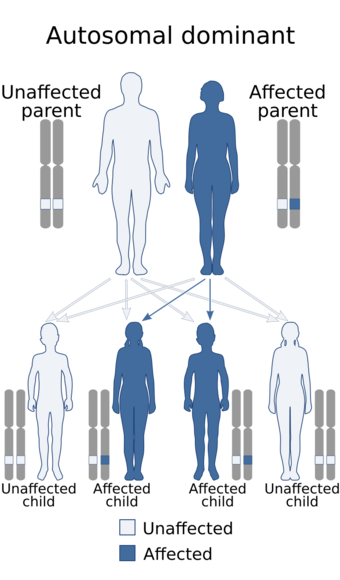Medicine:Branchio-oto-renal syndrome
| Branchio-oto-renal syndrome | |
|---|---|
| Other names | BOR syndrome, Branchiootorenal syndrome |
 | |
| Branchio-oto-renal syndrome has an autosomal dominant pattern of inheritance. | |
| Symptoms | Ear abnormalities[1] |
| Causes | Mutations in genes, EYA1, SIX1, and SIX5[2] |
| Diagnostic method | Laboratory test results, Physical exam[3] |
| Treatment | Branchial fistula may need surgery[3] |
Branchio-oto-renal syndrome (BOR)[4][5] is an autosomal dominant genetic disorder involving the kidneys, ears, and neck. It is also known as Melnick-Fraser syndrome.[2][3]
Signs and symptoms
The signs and symptoms of branchio-oto-renal syndrome are consistent with underdeveloped (hypoplastic) or absent kidneys with resultant chronic kidney disease or kidney failure. Ear anomalies include extra openings in front of the ears, extra pieces of skin in front of the ears (preauricular tags), or further malformation or absence of the outer ear (pinna). Malformation or absence of the middle ear is also possible, individuals can have mild to profound hearing loss. People with BOR may also have cysts or fistulae along the sides of their neck.[1] In some individuals and families, renal features are completely absent. The disease may then be termed "branchio-oto syndrome" (BO syndrome).[6][7]
Cause
The cause of branchio-oto-renal syndrome are mutations in genes, EYA1, SIX1, and SIX5 (approximately 40 percent of those born with this condition have a mutation in the EYA1 gene).[1][8] Many different abnormalities in these genes have been identified.[9]
Mechanism
The genetics of branchio-oto-renal syndrome indicate it is inherited in an autosomal dominant manner with variable clinical manifestations affecting branchial, renal, and auditory development. The varying clinical expression of the disease between different families suggests that multiple loci may be involved. In 1992, using genetic linkage studies, the BOR gene is identified on chromosome 8,[10] Subsequently, another locus on human chromosome 14 is identified, and several mutations are reported in genes EYA1, SIX1,[11] and SIX5.[12][13] Autosomal dominant inheritance indicates that the defective gene responsible for a disorder is located on an autosome, and only one copy of the gene is sufficient to cause the disorder, when inherited from a parent who has the disorder. This gene is involved in many facets of embryonic development and is important in the normal formation of many organs and tissues, including the ears, and kidneys before birth.[14]
Diagnosis
Diagnosis of BO syndrome or BOR syndrome is clinical, i.e. based on observing an appropriate combination of symptoms.[6] Only about half of patients have a detectable genetic abnormality, mostly in the EYA1 gene, SIX1 gene or the SIX5 gene.[6]
Treatment

The treatment of branchio-oto-renal syndrome is done per each affected area (or organ). For example, a person with hearing problems should have appropriate supports and prompt attention for any inflammation of the ear.[6][15]
A specialist should observe any kidney problems. Surgical repair may be needed depending on the degree of a defect or problem, whether a transplant or dialysis is needed.[16]
Epidemiology
The epidemiology of branchio-oto-renal syndrome has it with a prevalence of 1/40,000 in Western countries. A 2014 review found 250 such cases in the country of Japan.[17]
See also
- Lachiewicz Sibley syndrome
- Branchio-oculo-facial syndrome
References
- ↑ 1.0 1.1 1.2 "Branchio Oto Renal Syndrome" (in en-US). NORD (National Organization for Rare Disorders). https://rarediseases.org/rare-diseases/branchio-oto-renal-syndrome/.
- ↑ 2.0 2.1 "Branchiootorenal syndrome". Genetics Home Reference. U.S. National Library of Medicine. 2015-11-23. http://ghr.nlm.nih.gov/condition/branchiootorenal-syndrome.
- ↑ 3.0 3.1 3.2 "Branchiootorenal syndrome | Disease | Overview". Genetic and Rare Diseases Information Center (GARD) – an NCATS Program. https://rarediseases.info.nih.gov/gard/10147/disease/resources/1.
- ↑ "Branchio-oto-renal Syndrome". Genetic Hearing Loss. New York: Marcel Dekker Inc. 2004. doi:10.1201/9780203913062. ISBN 9780203913062. https://www.taylorfrancis.com/chapters/edit/10.1201/9780203913062-15/branchio-oto-renal-syndrome-shrawan-kumar.
- ↑ "Branchio-oto-renal syndrome: identification of novel mutations, molecular characterization, mutation distribution, and prospects for genetic testing". Genetic Testing 1 (4): 243–251. 1997. doi:10.1089/gte.1997.1.243. PMID 10464653.
- ↑ 6.0 6.1 6.2 6.3 "Branchiootorenal Spectrum Disorder". Branchiootorenal Spectrum Disorders. Seattle (WA): University of Washington, Seattle. 1993-01-01. https://www.ncbi.nlm.nih.gov/books/NBK1380/.|updated, 2015|
- ↑ "Autosomal-dominant branchio-otic (BO) syndrome is not allelic to the branchio-oto-renal (BOR) gene at 8q13". American Journal of Medical Genetics 76 (5): 395–401. April 1998. doi:10.1002/(sici)1096-8628(19980413)76:5<395::aid-ajmg6>3.0.co;2-m. PMID 9556298.
- ↑ (in en) Kidney Development, Disease, Repair and Regeneration. Academic Press. 2015-08-06. p. 269. ISBN 9780128004388. https://books.google.com/books?id=mCpOBQAAQBAJ.
- ↑ Branchiootorenal Spectrum Disorder. Seattle (WA): University of Washington, Seattle. 1993. http://www.ncbi.nlm.nih.gov/books/NBK1380/. Retrieved 2022-11-13.
- ↑ "Autosomal dominant branchio-oto-renal syndrome--localization of a disease gene to chromosome 8q by linkage in a Dutch family". Human Molecular Genetics 1 (7): 491–495. October 1992. doi:10.1093/hmg/1.7.491. PMID 1307249.
- ↑ "SIX1 mutations cause branchio-oto-renal syndrome by disruption of EYA1-SIX1-DNA complexes". Proceedings of the National Academy of Sciences of the United States of America 101 (21): 8090–8095. May 2004. doi:10.1073/pnas.0308475101. PMID 15141091. Bibcode: 2004PNAS..101.8090R.
- ↑ "Mutation screening of the EYA1, SIX1, and SIX5 genes in a large cohort of patients harboring branchio-oto-renal syndrome calls into question the pathogenic role of SIX5 mutations". Human Mutation 32 (2): 183–190. February 2011. doi:10.1002/humu.21402. PMID 21280147. https://hal.archives-ouvertes.fr/hal-00612007/file/PEER_stage2_10.1002%252Fhumu.21402.pdf.
- ↑ Online Mendelian Inheritance in Man (OMIM) Branchiootorenal Syndrome 1; BOR1 -113650
- ↑ "Mutations in SIX1 Associated with Branchio-oto-Renal Syndrome (BOR) Differentially Affect Otic Expression of Putative Target Genes". Journal of Developmental Biology 9 (3): 25. June 2021. doi:10.3390/jdb9030025. PMID 34208995.
- ↑ (in en) Cochlear Implants: Principles & Practices. Lippincott Williams & Wilkins. 2009-01-01. p. 53. ISBN 9780781777490. https://books.google.com/books?id=VUisHOM--UkC&q=Branchio-oto-renal%2520syndrome&pg=PA53.
- ↑ "Ear and kidney syndromes: molecular versus clinical approach". Kidney International 65 (2): 369–385. February 2004. doi:10.1111/j.1523-1755.2004.00390.x. PMID 14717907.
- ↑ "Branchio-oto-renal syndrome: comprehensive review based on nationwide surveillance in Japan". Pediatrics International 56 (3): 309–314. June 2014. doi:10.1111/ped.12357. PMID 24730701.
Further reading
- "A family with the branchio-oto-renal syndrome: clinical and genetic correlations". Nephrology, Dialysis, Transplantation 17 (6): 1014–1018. June 2002. doi:10.1093/ndt/17.6.1014. PMID 12032190.
- (in en) Ballenger's Otorhinolaryngology: Head and Neck Surgery. PMPH-USA. 2009-01-01. ISBN 9781550093377. https://books.google.com/books?id=sGhzMnst1j8C.
External links
| Classification |
|---|
 |

